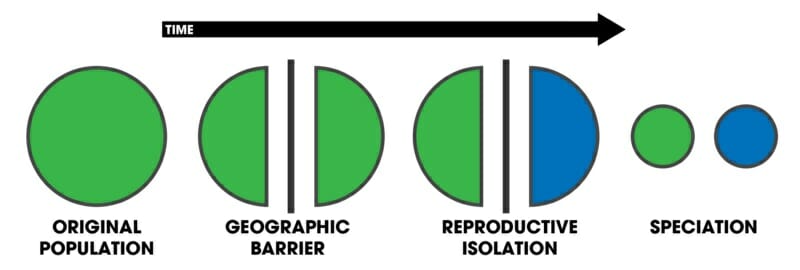Describe the Process Through Which Allopatric Speciation
86 is a mode of speciation that occurs when biological populations become geographically isolated from each other to an extent that prevents or interferes with gene flow. This is different from sympatric speciation where the two populations might live in the same place but.

Difference Between Allopatric And Sympatric Speciation
Speciation occurs even through the two groups are still living in the same area What are the steps in allopatric speciation.
. When the ancestral population is split into two or more smaller populations by the a geographical barrier for example a mountain range then will not be able to encounter. The evolutionary process that leads to the formation of a new species from an existing one is termed as speciation. Speciation is a slow process due to which populations evolve into different species.
Organisms produce more offspring than is needed to replace them when they die. Allopatric speciation occurs when a population of organisms becomes separated or isolated from their main group. 1 geographic isolation occurs 2 two populations must become isolated geographically from one another 3 the become separate species or interbreed.
Allopatric Speciation is the speciation creation of new species due to separation of an ancestral population by a geographical barrier. These geographical barriers can be a mountain range a river lake bed etc. Features such as rivers or mountain ranges isolate populations of animals and plants.
Multiply vary let the strongest live and the weakest die Charles Darwin. Sympatric speciation is the evolution of new species from a single ancestral species while living in the same habitat. Allopatric speciation is when new species arise due to isolation of a population by geographical barriers.
Over time the allele frequency in the new group which used to be homogenous across the individuals becomes subject to changes via natural selection due to of pressure from differences in predators climate competitors and resources. Allopatric speciation is a type of speciation that occurs when two original populations of the same species and characteristics become geographically separated from one another. Allopatric speciation is just a fancy name for speciation by geographic isolation discussed earlier.
In this type of speciation the isolation is created by physical obstacles like rivers deserts long distances or mountains that prohibit them from regularly mating resulting in a. There will then be 2 isolated groups of the same species unable to interbreed with each other. Allopatric geographic speciation is the differentiation of physically isolated populations to the point that reunion of the two populations does not occur if contact is re- established.
Scientists have documented numerous cases of allopatric speciation. Isolation might occur because of great distance or a physical barrier such. Allopatric speciation from Ancient Greek ἄλλος állos other and πατρίς patrís fatherland also referred to as geographic speciation vicariant speciation or its earlier name the dumbbell model.
Allopatric speciation also called geographic speciation is a common mechanism by which new species are formed. Allopatric Speciation This type of speciation happens when two populations of the same species become isolated from each other due to geographic factors. What is sympatric speciation.
How can sympatric speciation occur if the individuals a population are not geographically isolated. Population numbers tend to stay about the same. The first three patterns suggested to Darwin that individuals compete with each other for scarce resources.
Explain the process of allopatric speciation A population of one species is separated by a physical barrier eg a geographical barrier such as the movement of tectonic plates. BiologyWise provides a brief description of the four basic modes of speciation namely allopatric parapatric peripatric and sympatric speciation. Resources such as food water and space are limited.
Allopatric speciation is the physical isolation of a biological population by an extrinsic barrier evolving an intrinsic reproductive isolation. First the species must be split into two by a geographic feature then they will adapt separately creating new species. This type of speciation is characterized by the division of an original population.
During the process of evolution the formation of new and distinct species is defined as. Allopatric speciation Speciation via Geographical separation The process of speciation that take place when the members of the population are isolated geographically from each other where they are unable to mate and hence genetic exchange is prevented or interfered is termed as allopatric speciation. The biological equivalent is allopatric speciation an evolutionary process in which one species divides into two because the original homogenous population has.
Describe the process through which allopatric speciation can produce new species. In this mode of speciation something extrinsic to the organisms prevents two or more groups from mating with each other regularly eventually causing that lineage to speciate. Biologists group allopatric processes into two categories.
Dispersal occurs when a few members of a species move to a new geographical area while vicariance occurs when a natural situation arises to physically divide organisms. Speciation as a Gradual Process. Allopatric speciation is speciation that occurs because populations live in different places.

Possibly Helpful Image Evolution Genetic Variation Homework Help

What Does Allopatric Speciation Require Biology Dictionary Fun Facts Experiments Preferences

The Evolutionary Process That Leads To The Formation Of A New Species From An Existing One Is Termed As Speciation Buzzle P Science Lessons Biology Stem Basic
No comments for "Describe the Process Through Which Allopatric Speciation"
Post a Comment